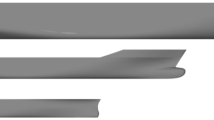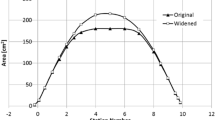Abstract
A computational method for improving hull form in shallow water with respect to wave resistance is presented. The method involves coupling ideas from two distinct research fields: numerical ship hydrodynamics and nonlinear programming techniques. The wave resistance is estimated by means of Morino’s panel method, which is extended to free surface flow and considers the influence of finite depth on the wave resistance of ships. This is linked to the optimization procedure of the sequential quadratic programming (SQP) technique, and an optimum hull form can be obtained through a series of iterations giving some design constraints. Sinkage is an important factor in shallow water, and this method considers sinkage as a hydrodynamic design constraint. The optimization procedure developed is demonstrated by selecting a Wigley (C B = 0.444) hull and the Series 60 (C B = 0.60) hull, and new hull forms are obtained at Froude number 0.316. The Froude number specified corresponds to a lower than critical speed since most of the ships operating in shallow water move below their critical speed. The numerical results of the optimization procedure indicate that the optimized hull forms yields a reduction in wave resistance.
Similar content being viewed by others
Author information
Authors and Affiliations
Corresponding author
About this article
Cite this article
Saha, G., Suzuki, K. & Kai, H. Hydrodynamic optimization of ship hull forms in shallow water. J Mar Sci Technol 9, 51–62 (2004). https://doi.org/10.1007/s00773-003-0173-3
Received:
Accepted:
Issue Date:
DOI: https://doi.org/10.1007/s00773-003-0173-3




